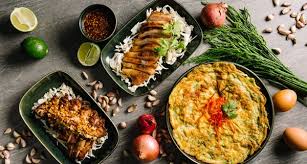Thai cuisine is a simple yet clever combination of Eastern and
Western influences harmoniously combined into that je ne sais quoi.
Sour, sweet, salty, bitter and spicy flavours work together to make each
dish come alive. Thai food varies depending upon the area or region of
Thailand the dish originates from. These regions include the north,
northeast, south and central.


It might be hard to believe, but Thai food used to be a lot more spicy than it is now, but over the years to was toned down, and fewer and less spices were used in Thai curries, while the use of fresh herbs, such as lemon grass and galangal, increased.Thai food was traditionally eaten with the right hand while seated on mats or carpets on the floor as still happens in the more traditional households. It is now generally eaten with a fork and spoon. Despite China having such an influence on both the country and the food, chopsticks are rarely used, even when eating noodles.Nowadays, Thailand as a tourist destination and a regional economic power has had a major impact on the cuisine, and the growth of fast food restaurants such as McDonalds, Subway, KFC, Pizza Hut and other restaurants has boomed, especially in the large cities and tourist areas. Not only are the tourists and expats eating it, but Thai people are as well. Whilst generally Thai people are not fans of what they consider to be “farang food” viewing it as bland, the acceptance of fast food, suggests there could be further changes to come in the future with Thai cuisines.Thai cuisine is the national cuisine of Thailand. Balance, detail, and variety are of paramount significance to Thai chefs.
Thai cooking places emphasis on lightly prepared dishes with strong aromatic components and a spicy edge. It is known for its complex interplay of at least three and up to four or five fundamental taste senses in each dish or the overall meal: sour, sweet, salty, bitter, and spicy. Australian chef David Thompson, a prolific chef and expert on Thai food, observes that unlike many other cuisines,Thai cooking rejects simplicity and is about "the juggling of disparate elements to create a harmonious finish". Thai chef McDang characterises Thai food as demonstrating "intricacy; attention to detail; texture; color; taste; and the use of ingredients with medicinal benefits, as well as good flavor", as well as care being given to the food's appearance, smell and context.
Thai cuisine is one of the most popular cuisines in the world. In 2011, seven of Thailand's popular dishes appeared on the list of the "World's 50 Most Delicious Foods"— a worldwide online poll of 35,000 people by CNN Travel.Regional cuisines and historical influences:-Thai cuisine is more accurately described as four regional cuisines, corresponding to the four main regions of the country:
-Central Thai cuisine of the flat and wet central rice-growing plains and of Bangkok, site of the former Thai kingdoms of Sukhothai and Ayutthaya, and the Dvaravati culture of the Mon people from before the arrival of Tai groups in the area.
-Isan or northeastern Thai cuisine of the more arid Khorat Plateau, similar in culture to Laos and also influenced by Khmer cuisine to its south, as evidenced by the temple ruins from the time of the Khmer Empire.
-Northern Thai cuisine of the verdant valleys and cool, forested mountains of the Thai highlands, once ruled by the former Lanna Kingdom and home to the majority of the ethnic groups of Thailand.
-Southern Thai cuisine of the Kra Isthmus which is bordered on two sides by tropical seas, with its many islands and including the ethnic Malay, former Sultanate of Pattani in the deep south.
Thai cuisine and the culinary traditions and cuisines of Thailand's neighbors have mutually influenced one another over the course of many centuries. Regional variations tend to correlate to neighboring states (often sharing the same cultural background and ethnicity on both sides of the border) as well as climate and geography. Northern Thai cuisine shares dishes with Shan State in Burma, northern Laos, and also with Yunnan Province in China, whereas the cuisine of Isan (northeastern Thailand) is similar to that of southern Laos, and is also influenced by Khmer cuisine from Cambodia to its south, and by Vietnamese cuisine to its east. Southern Thailand, with many dishes that contain liberal amounts of coconut milk and fresh turmeric, has that in common with Indian, Malaysian, and Indonesian cuisine.In addition to these four regional cuisines, there is also the Thai royal cuisine which can trace its history back to the cosmopolitan palace cuisine of the Ayutthaya kingdom . Its refinement, cooking techniques, presentation, and use of ingredients were of great influence to the cuisine of the central Thai plains.

Many dishes that are now popular in Thailand were originally Chinese dishes. They were introduced to Thailand by the Hokkien people starting in the 15th century, and by the Teochew people who started settling in larger numbers from the late 18th century CE onward, mainly in the towns and cities, and now form the majority of the Thai Chinese.Such dishes include chok Thai: rice porridge), salapao (steamed buns), kuaitiao rat na (fried rice-noodles) and khao kha mu (stewed pork with rice). The Chinese also introduced the use of a wok for cooking, the technique of deep-frying and stir frying dishes, several types of noodles, taochiao (fermented bean paste), soy sauces, and tofu.The cuisines of India and Persia, brought first by traders, and later settlers from these regions, with their use of dried spices, gave rise to Thai adaptations and dishes such as kaeng kari (yellow curry) and kaeng matsaman.
No comments:
Post a Comment